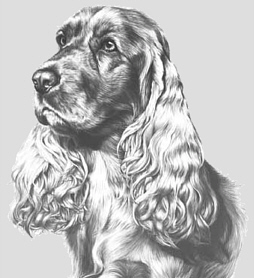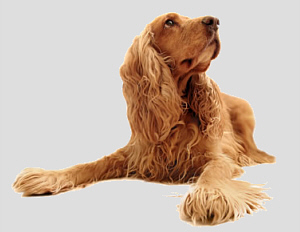
|
 English Cocker Spaniel
The English Cocker Spaniel is a breed of gun dog. It is one of several varieties of spaniel and somewhat resembles its American cousin, the American Cocker Spaniel, although it's closer to the working-dog form of the Field Spaniel and the Springer Spaniel. Outside the US, the breed is usually known simply as the Cocker Spaniel, as is the American Cocker Spaniel within the US. Due to the breed's happy disposition and continuously wagging tail, it has been given the nickname "merry cocker".
|
 Domain for sale Domain for sale
|
Appearance
 The Cocker is a sturdy, compact, well-balanced dog. It has a characteristic expression showing intelligence and alertness. Its eyes should be dark and its lobular ears should reach the tip of the nose when pulled forward. Today, a significant difference in appearance exists between field-bred and conformation show-bred dogs. The Cocker's tail is customarily docked in North America. In some countries the tail is generally docked at about 4 or 5 inches in field-bred dogs while show dogs generally are docked closer to the body.
The Cocker is a sturdy, compact, well-balanced dog. It has a characteristic expression showing intelligence and alertness. Its eyes should be dark and its lobular ears should reach the tip of the nose when pulled forward. Today, a significant difference in appearance exists between field-bred and conformation show-bred dogs. The Cocker's tail is customarily docked in North America. In some countries the tail is generally docked at about 4 or 5 inches in field-bred dogs while show dogs generally are docked closer to the body.
Size
Height at withers:
Dogs: 15-17 inches (38 43 cm)
Bitches: 15-16 inches (38 41 cm)
Weight:
Dogs: 28 34 lb (13 15 kg)
Bitches: 27 32 lb (12-15 kg)
|
Colour
Show dogs are restricted to certain colours dependent on country, whereas working Cockers can be any of a wide variety of colours. They come in solid (or "self"), where white is restricted to only the chest in show dogs, parti-colour and roan.
The colours in the breed consist of black, black and tan, black and white, black white and tan, blue roan, blue tick, blue roan and tan, silver, chocolate, chocolate and tan, chocolate and white, chocolate white and tan, chocolate roan, chocolate roan and tan, sable, copper red, red, gold, red roan, red and white, apricot, orange, orange and white, orange roan, lemon, lemon and white, lemon roan.
Although field-bred and show dogs are found in largely the same colours, some hunters prefer to have white in the coat to make the dog more visible to gunners.
Temperament
Cockers are renowned for their friendly, faithful, playful, quiet and affectionate natures. They are easily trained and make a good medium-sized family pet. Very few Cockers have temperament problems; in a 2002 survey consisting of 487 Cockers, only 1% of the dogs were aggressive to people and 2% were aggressive to other dogs. English cockers have a loving temperament and make excellent family pets. They will often bond to one person in a family. They have a "go do it now" attitude.
Health
Mortality
English Cocker Spaniels in UK and USA/Canada surveys had a median lifespan of 11 to 12 years, which is a typical longevity for purebred dogs, but a little less than most other breeds of their size. The English Cocker Spaniel typically lives about a year longer than the smaller American Cocker Spaniel.
In a 2004 UK Kennel Club survey, the most common causes of death were cancer (30%), old age (17%), cardiac (9%), and "combinations" (7%). In 1998 and 2002 USA/Canada Health Surveys, the leading causes of death were old age (40%) and cancer (22%).
Morbidity
Common health issues with English Cockers are bite problems, skin allergies, shyness, cataracts, deafness, aggression towards other dogs, and benign tumors.
3 month old gold English Cocker puppySome uncommon health issues that can also have an effect on English Cocker Spaniels include canine hip dysplasia, patellar lunation, canine dilated cardiomyopathy, and heart murmurs. Hip dysplasia is an abnormal formation of the hip joint. Patellar Lunation, also known as luxating patella, refers to the dislocation of the kneecap. Canine dilated cardiomyopathy involves heart failure.
Skills
A field-bred cocker spaniel is first and foremost an upland flushing dog. In performing this task there are some skills the dog must be trained to perform.
 Hup: This is the traditional command to sit and stay. To be an effective hunter the dog must comply with this command absolutely. When hupped the dog can be given direction called to the handler. The ability to hup a dog actively working a running bird allow the handler and any gunners to keep up without having to run.
Hup: This is the traditional command to sit and stay. To be an effective hunter the dog must comply with this command absolutely. When hupped the dog can be given direction called to the handler. The ability to hup a dog actively working a running bird allow the handler and any gunners to keep up without having to run.
Retrieve to Hand: The majority of hunters and all hunt test or field trial judges require that a dog deliver a bird to hand, meaning that a dog will hold the bird until told to give it to the hunter directly.
Quarter: Dogs must work in a pattern in front of the hunter seeking upland game birds. The dog must be taught to stay within gun range to avoid flushing a bird outside of shooting distance.
Follow Hand Signals: Upland hunting involves pursuing wild game in its native habitat. Gun dogs must investigate likely covers for upland game birds. The dog must be responsive to hand signals in order for the hunter to be able to direct the dog into areas of particular interest.
Steady: When hunting upland birds, a flushing dog should be steady to wing and shot, meaning that he sits when a bird rises or a gun is fired. He does this in order to mark the fall and to avoid flushing other birds when pursuing a missed bird.
History
Spaniel type dogs have been found in art and literature for almost 500 years. Initially, spaniels in England were divided among land spaniels and water spaniels. The differentiation among the spaniels that led to the breeds that we see today did not begin until the mid 1800s. During this time, the land spaniels became a bit more specialized and divisions among the types were made based upon weight. According to the 1840 Encyclopedia of Rural Sports, Cockers were between 12 and 20 lb. At this time it was not uncommon for Cockers and Springers to come from the same litter. Even a puppy from a Toy sized lineage could grow to be a springer.
There is no indication from these early sources that spaniels were used to retrieve game. Rather they were used to drive the game toward the guns.
During the 1850s and 60s other dogs types of Cockers were recorded. There were Welsh Cockers and Devonshire Cockers. Additionally, small dogs from Sussex Spaniel litters were called Cockers. In 1874 the first stud books were published by the newly formed kennel club. Any spaniel under 25 lb was placed in the Cocker breeding pool, however the Welsh Cocker was reclassified as a Springer in 1903 due to its larger size and shorter ear. "...in those days only those dogs up to a hard days work and sensible specimens were allowed to live, as absolute sporting purposes were about their only enjoyment and dog shows were hardly heard of...".
The hobby of conformation showing began in earnest among spaniels after the Spaniel Club was formed in 1885. When showing, the new Springer and Cocker, both were in the same class until The Spaniel Club created breed standards for each of the types. The Kennel Club separated the two types eight years later. Since then, the Springer and Cocker enthusiasts have bred in the separate traits that they desired. Today, the breed differ in more ways than weight alone.
In America, the American Cocker Spaniel type was forming. As a result, the English Cocker lost favour. The two Cocker Spaniels were shown together until 1936, when the English Cocker received status as a separate breed. The American Kennel Club granted a separate breed designation for the English Cocker Spaniel in 1946.
Working Cockers
This breed, like many others with origins as working dogs, has some genetic lines that focus on working-dog skills and other lines that focus on ensuring that the dog's appearance conforms to a breed standard; these are referred to as the "working" (or "field-bred") and "show dog" strains, respectively.
After World War II, the show-bred Cocker Spaniel increased enormously in popular appeal and, for a while, was the most numerous Kennel Club registered breed. This popularity increased the view that all Cockers were useless as working dogs. However, for many dogs this is untrue, as even some show-bred Cockers have retained their working instinct.
Today, this breed is experiencing a resurgence in usage as a working and hunting dog. Dogs from working lines are noticeably distinct in appearance. As is the case with the English Springer Spaniel, the working type has been bred exclusively to perform in the field as a hunting companion. Their coat is shorter and ears less pendulous than the show-bred type. Although registered as the same breed, the two strains have diverged significantly enough that they are rarely crossed. The dogs that have dominated the hunt test, field trial and hunting scene in the United States are field-bred dogs from recently imported British lines.
Working-dog lines often have physical characteristics that would prevent them from winning in the show ring. This is a result of selecting for different traits than those selected by show breeders. The longer coat and ears, selected for the show ring, are an impediment in the field.
Cuban authorities train and use English Cocker Spaniels as sniffer dogs to check for drugs or food products in passengers' baggage at Cuban airports.

TOP

|
|
|